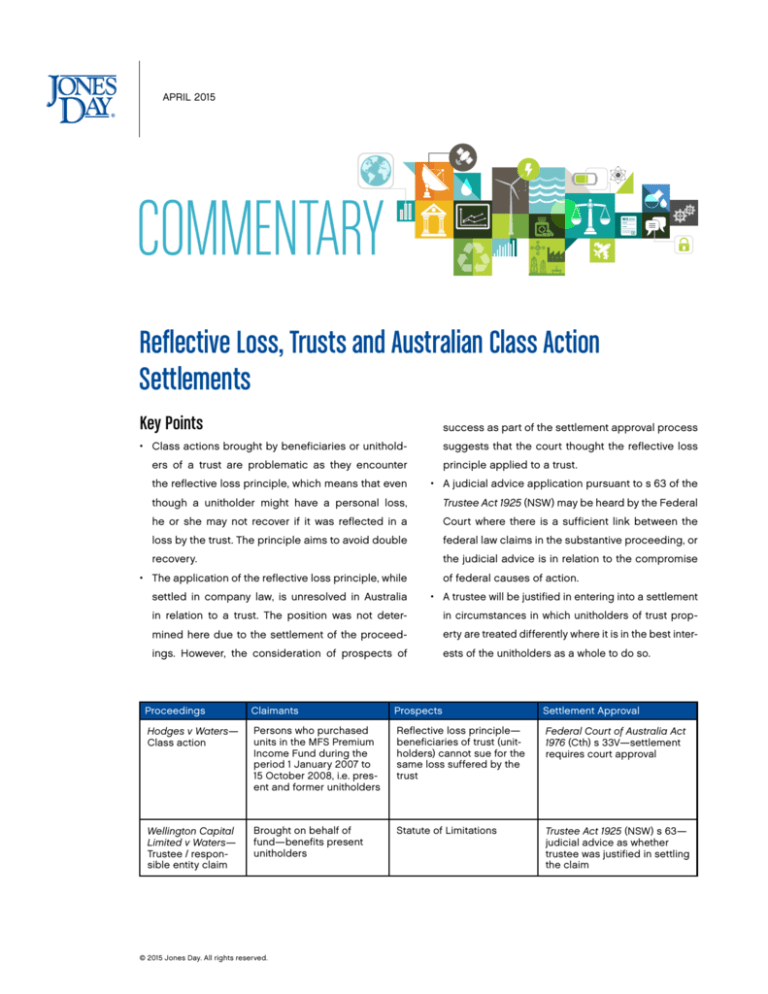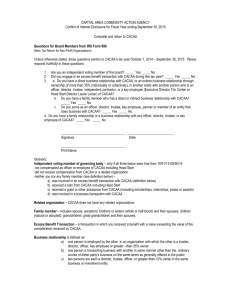
APRIL 2015
COMMENTARY
Reflective Loss, Trusts and Australian Class Action
Settlements
Key Points
success as part of the settlement approval process
• Class actions brought by beneficiaries or unithold-
suggests that the court thought the reflective loss
ers of a trust are problematic as they encounter
principle applied to a trust.
the reflective loss principle, which means that even
• A judicial advice application pursuant to s 63 of the
though a unitholder might have a personal loss,
Trustee Act 1925 (NSW) may be heard by the Federal
he or she may not recover if it was reflected in a
Court where there is a sufficient link between the
loss by the trust. The principle aims to avoid double
federal law claims in the substantive proceeding, or
recovery.
the judicial advice is in relation to the compromise
• The application of the reflective loss principle, while
of federal causes of action.
settled in company law, is unresolved in Australia
• A trustee will be justified in entering into a settlement
in relation to a trust. The position was not deter-
in circumstances in which unitholders of trust prop-
mined here due to the settlement of the proceed-
erty are treated differently where it is in the best inter-
ings. However, the consideration of prospects of
ests of the unitholders as a whole to do so.
Proceedings
Claimants
Prospects
Settlement Approval
Hodges v Waters—
Class action
Persons who purchased
units in the MFS Premium
Income Fund during the
period 1 January 2007 to
15 October 2008, i.e. present and former unitholders
Reflective loss principle—
beneficiaries of trust (unitholders) cannot sue for the
same loss suffered by the
trust
Federal Court of Australia Act
1976 (Cth) s 33V—settlement
requires court approval
Wellington Capital
Limited v Waters—
Trustee / responsible entity claim
Brought on behalf of
fund—benefits present
unitholders
Statute of Limitations
Trustee Act 1925 (NSW) s 63—
judicial advice as whether
trustee was justified in settling
the claim
© 2015 Jones Day. All rights reserved.
Background
Prospects of Success—Reflective Loss and the
Statute of Limitations
In 2008, the value of units of the MFS Premium Income Fund
(the “Fund”), a property trust, diminished in value following
To avoid double recovery, the right to sue for harm done to
the tightening in credit markets as a result of the global finan-
a trust is vested in the trustee. The beneficiaries of a trust
cial crisis.
(in this case, the unitholders in the Fund) cannot sue in their
own names. However, the class members sought to evade
It transpired that the Fund had entered into a number of loss-
the restriction on standing by seeking compensation for their
making transactions that were not in accordance with its
individual harm but then confronted the reflective loss prin-
“Compliance Plan”. The Compliance Plan governed the inter-
ciple. In company law, the reflective loss principle means that
nal compliance arrangements under which the Fund was to be
even though a shareholder might have a personal loss, he or
conducted. An external person had been appointed to audit
she could not recover if it was reflected in a loss by the com-
the Fund’s observance of the Compliance Plan but, among
pany for which it could sue. The issue in the class action was
other things, had failed to detect that a number of the loss-
whether the reflective loss principle applied to a unit trust
making transactions were with related parties to the Fund.
such as the Fund.
In 2009, the applicants, a group of present and former unit-
Perram J determined in Mercedes Holdings Pty Ltd v Waters
holders in the Fund, commenced an open-class representa-
(No 8) [2013] FCA 601 that the class members had made no
tive proceeding against Waters (the external auditor), the audit
non-reflective loss claims and declined an application to
team of which Waters was a member, persons involved in the
amend to raise such claims. The class members appealed
management of the Fund and Octaviar Limited (the Fund’s
this decision, but on the day the appeal was to be heard, the
former responsible entity) (the “class action proceedings”).
in principle settlement of both the class action proceedings
and the Trustee’s proceedings was announced.
The class was defined to consist of persons who had purchased
units in the Fund between 1 January 2007 and 15 October 2008.
Perram J was of the view that there was a “substantial
Excluded from the class were current unitholders who had not
chance”1 that the class members would lose in relation to
purchased the units during the relevant time.
the reflective loss issue and their claim would be dismissed,
exposing them to pay costs since 2009.
The prospects of success for the class action proceedings
turned on whether the reflective loss principle—beneficiaries
The Trustee’s proceedings did not have the same issues in
of a trust (unitholders) cannot sue for the same loss suffered
relation to reflective loss; Wellington unquestionably had
by the trust—applied.
standing to pursue claims about harm done to the Fund. 2
However, many of the causes of action which Wellington
In 2013, the current responsible entity of the Fund, Wellington
Capital had obtained upon its succession to the trusteeship
Capital Limited, was persuaded to commence its own action
of the Fund were arguably statute barred by the time it com-
(the “Trustee’s proceedings”). The prospects of success for
menced its proceeding.
the Trustee’s proceedings were significantly hampered by
Perram J found that:
the statute of limitations.
Approval was sought for the settlement of the class action
In my opinion, the most likely outcome to this litigation was
proceedings and for judicial advice as to whether the trustee
that it would be lost. There was a high risk that the appli-
was justified in settling the Trustee’s proceedings. Both
cants had no standing to proceed and a good chance
required consideration of the prospects of success of the
the bulk of the trustee’s claim was statute barred. 3
respective claims.
2
Jones Day Commentary
Issues from the Combined Settlement
success of the claims and was of the view that the proposed
The combined settlement of the class action proceedings
members’ best outcome due to the substantial chance that
and the Trustee’s proceedings created a difficulty as the
the determination of the reflective loss issue would lead to the
positions of each of the persons involved in the settlement
dismissal of the applicants’ claim and ensuing costs orders.
settlement stood a significant chance of being the class
were not the same. Perram J explained:
The court did not disclose the quantum of the settlement but
(a) any money obtained by the trustee for harm done to
based on the judge’s view that the claim was worth $80 mil-
the trust assets will increase the value of the units which
lion and the probable, although not certain, outcome that the
are held by the present unitholders. Not all of those uni-
case would be lost, the payment was considered to be “a
tholders, however, acquired their units during the class
good settlement”. 5
definition period of 1 January 2007 to 15 October 2008,
i.e., not every current unitholder in the Fund is a class
The court also considered the expenses incurred in relation
member;
to legal fees and litigation funding.
(b) the class action claim is principally for reflective loss
definition period. They claim for the diminution in the
Judicial Advice Application—s 63 of the Trustee
Act 1925 (NSW)
value of their units;
By reaching a settlement of the claims, Wellington Capital,
suffered by persons who were unitholders in the class
as trustee, exposed itself to the potential risk that present
(c) those class members need not have retained their
unitholders would view the settlement as a breach of trust. A
units, i.e., not all class members are present unitholders.
trustee confronted by a difficult or controversial decision is
Worse, amongst those that have sold their units, they will
permitted in the State of New South Wales to approach the
have sold at different times and for different prices; and
Supreme Court of that State for judicial advice. To prevent
liability for a breach of trust, Wellington Capital sought judi-
(d) for those class members who remain unitholders they
cial advice pursuant to s 63 of the Trustee Act 1925 (NSW).
will also be enriched by any funds recovered by the trustee
in its action as well as by their class action claim, i.e., they
recover
Judicial advice pursuant to s 63 is usually dealt with by the
twice.4
Supreme Court of New South Wales. However, Perram J reasoned that as the claim for judicial advice arose from the
To address these issues, the settlement was constructed
same substratum of facts as its actual claim, the link between
so that payments were made only to individuals and not to
the actual claim and the application for judicial advice was
the Fund. Further, payments were made only to class mem-
sufficient to allow it to be heard by the Federal Court within its
bers, so that some current unitholders were excluded from
accrued jurisdiction. Perram J then went further and held that
any recovery. The unequal treatment of current unitholders,
any claim for judicial advice in relation to the compromise of
some being class members and some not, then had to be
federal causes of action is in federal jurisdiction.
addressed as part of the judicial advice application. However,
from the class action position, limiting compensation to only
A key issue for consideration under the application was the
the group members meant the settlement conformed with
unequal treatment of current unitholders. The assets of the trust
the usual approach in class actions.
include the choses in action against Ms Waters and the audit
team. Those assets will be extinguished as part of the settlement but the non-class member unitholders will receive nothing
Approval of the Class Action Settlement
as a result of the settlement. However, the trustee was required
Class action settlements must be fair and reasonable for the
by the constitution of the Fund to treat unitholders equally.
court to grant approval. Perram J considered the prospects of
3
Jones Day Commentary
Endnotes
Perram J considered that the difference in treatment between
the class members and unitholders that were not members
1
Hodges v Waters (No 7) [2015] FCA 264 at [28].
settlement. This was because the settlement was in the best
2
Hodges v Waters (No 7) [2015] FCA 264 at [21].
interests of the unitholders as a whole for two reasons:
3
Hodges v Waters (No 7) [2015] FCA 264 at [89].
4
Hodges v Waters (No 7) [2015] FCA 264 at [56].
5
Hodges v Waters (No 7) [2015] FCA 264 at [92].
6
Hodges v Waters (No 7) [2015] FCA 264 at [83].
of the class was not a bar to finding it reasonable to enter the
• The trustee’s case was weak and the most likely outcome
was a loss; and
• The trustee’s case, in practical terms, could not be settled
unless at the same time the class action was settled.6
Perram J was also of the view that the settlement protected
the fund from the real risk of an adverse costs order against
the trust assets.
Perram J gave advice that Wellington Capital would be justified in settling the proceedings.
Lawyer Contacts
For further information, please contact your principal Firm
representative or one of the lawyers listed below. General
email messages may be sent using our “Contact Us” form,
which can be found at www.jonesday.com.
John Emmerig
Sydney
+61.2.8272.0506
jemmerig@jonesday.com
Michael Legg
Sydney
+61.2.8272.0720
mlegg@jonesday.com
Greta Gingell
Sydney
+61.2.8272.0579
ggingell@jonesday.com
4
Jones Day Commentary








